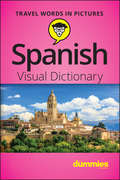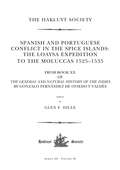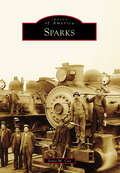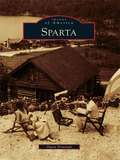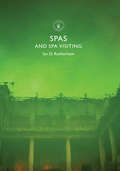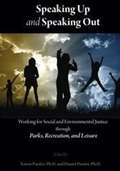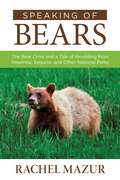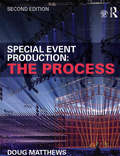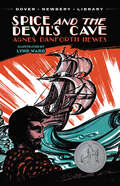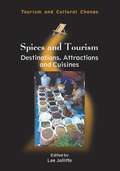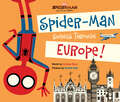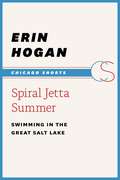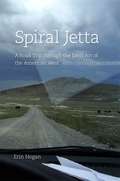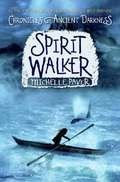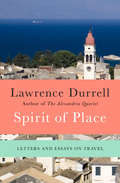- Table View
- List View
Spanish Tourism Geographies: Territorial Diversity and Different Approaches (Geographies of Tourism and Global Change)
by Macià Blázquez-Salom Asunción Blanco-RomeroThis book provides an overview of the progress in Spanish tourism geography, particularly after the overlay of financial, pandemic and climate crisis, by the scrutiny of the different geographical areas and variables of analysis. It shows the diversity of geographical environments and their varied relationship with tourism, from the emptied inland regions to urban heritage in historic centres to coastal resorts. The book also introduces the analysis of the most important variables when studying the implications of Spanish tourist specialization. How are the beaches with intensive tourist use managed? What socio-spatial processes do leisure-rooted migrations involve? What are the labour conditions in the Spanish tourism industry? How does saving water boost tourism growth? The book offers answers through a methodological specificity of Spanish geography, which is highly oriented towards the analysis of public policies and even the proposal of new planning and methodology formulas that go beyond diagnostic studies.The domestic perspective, or that of insiders, of these scientists residing in Spain bestows them with special codes for conducting interpretations and analyses based on their everyday proximity to a territory characterised by its intense touristification. The tourism and real estate specialisation that Spanish society, together with its territory and institutions, have forged since the beginning of “developmentalism” permeates this scientific analysis. By providing a strong conceptual and empirical portrait, this book is a great resource for students and scholars in geography of tourism, as well as for social scientists and policy makers.
Spanish Visual Dictionary For Dummies
by Consumer DummiesSpanish Visual Dictionary Learn Spanish vocabulary faster!It’s a fact—seeing something helps you remember it. This handy guide helps you build your Spanish vocabulary with full-color pictures illustrating every term. You’ll be able to communicate with native speakers faster as you learn and remember more words and their meanings. The book is organized by themes such as transportation, accommodations, restaurants and eating, sports, emergencies, and shopping, making it especially useful for travelers. Boost your learning speed and get talking in Spanish today!InsideTransportation terminologyGetting around a cityRestaurants and food ordersHandling an emergency
Spanish and Portuguese Conflict in the Spice Islands: From Book XX of The General and Natural History of the Indies by Gonzalo Fernández de Oviedo y Valdés (Hakluyt Society, Third Series)
by Glen F. DilleGonzalo Fernández de Oviedo y Valdés, (1478–1557), warden of the fortress and port of Santo Domingo of the Island of Hispaniola, also served his emperor, Charles V, as the official chronicler of the first half-century of the Spanish presence in the New World. His monumental General y Natural Historia de las Indias, consisting of three parts, with fifty books, hundreds of chapters and thousands of pages, is still a major primary source for researchers of the period 1492–1548. Part One, consisting of 19 books, was first published in 1535, then reprinted and augmented in 1547, with a third edition, including Book XX, the first book of Part II, appearing in Valladolid in 1557. Book XX, which was printed separately in Valladolid in 1557 (the year of Oviedo’s death), concerns the first three Spanish voyages to the East Indies. While it might be expected that the narrative of Magellan’s voyage would predominate in Book XX, Oviedo devoted only the first four chapters to this monumental voyage. The remaining thirty–one concern the two subsequent and little-known Spanish follow-up expeditions to the Moluccas 1525-35. The first, initially led by García Jofre de Loaysa, set out from Coruña to follow Magellan’s route through the Strait and across the Pacific. A second relief expedition under Alvaro Saavedra was sent out in search of Loaysa’s company from the Pacific coast of New Spain in 1527. In each venture only one vessel reached the Spice Islands. Oviedo’s narrative offers many details of the 10 years of hardships and conflict with the Portuguese, endured by the stoic Spanish, and of the growing unrest it provoked among their indigenous hosts. The news that Charles V had pawned his claim to the King João III of Portugal allowed a very few of the Spaniards to negotiate a passage back to Spain via Lisbon, while others remained in Portuguese settlements in the East Indies. The reports made by the returnees to the Consejo de Indias were integrated by Oviedo into his narrative, expanded and enriched by personal interviews. His chronicle includes much information about the indigenous culture, commerce, geography and of the exotic fauna and flora of the Spice Islands.
Sparks (Images of America)
by Joyce M. CoxIn the late 1800s, the area now known as Sparks consisted of ranches and farms. It was not until the early 1900s that Sparks would become the sixth-largest city in Nevada, almost overnight. E.H. Harriman moved the Salt Lake Division of the Southern Pacific Railroad from Wadsworth to swampland four miles east of Reno, and that area would become Sparks. The railroad was the largest and most reliable employer for 54 years, before leaving in 1957. Some railroad employees were transferred and reassigned to jobs outside of Sparks, but many chose to stay. Employment was found in Nevada’s thriving hospitality industry, including John Ascuaga’s Nugget Casino. Sparks became a major distribution center for national companies like S.S. Kresge and Pacific Freeport, and many manufacturing companies opened after Nevada passed the right-to-work law in 1951. Sparks is now the fifth-largest city in Nevada.
Sparta
by Gwen DonovanIncorporated in 1845, Sparta was once a Colonial farming village comprised of stone mills, general stores, and one-room schoolhouses. Summer visitors from surrounding metropolitan areas were drawn to Sparta in the late 1800s for the fresh mountain air. During that time, Thomas Edison came to Sparta to extract iron ore at his massive Edison village manufacturing plant on Sparta Mountain. The 1920s saw the development of Lake Mohawk, permanently changing the landscape of the township as the windswept Brogden Meadow was transformed into a sparkling 3-mile-long lake, which attracted hundreds of part-time residents. While Sparta is no longer a farming community, mining town, or seasonal vacation destination, today's residents take great pride in its small-town appeal and rich, colorful past.
Sparta Township
by Sparta Historical Commission Kathryn PaaschKnown for small-town charm and a beautiful countryside, the area known as Sparta Township was first settled in 1844, and over the next two years it would become home to those pursuing dreams in the logging industry. Rich in a variety of forests, and with the Rogue River and Nash Creek running through it, Sparta first developed saw and flour mills. In the late 1800s, the "Ridge" would develop along the western edge of town, where the land was prime for growing a variety of fruits. When the Pere Marquette Railroad passed through town, it brought opportunity for thriving industry, including the Welch Folding Bed Company, Carnation Creamery, and Sparta Foundry. Spartans enjoyed community picnics, apple smorgasbords, and The Lady of the Lake cruise ship that famously sank to the bottom of Camp Lake. A sense of close-knit community thrives in the area today.
Spas and Spa Visiting
by Ian RotherhamThe spa came into its own in Georgian Britain, with thousands flocking to take the waters at towns such as Bath, Cheltenham and Tunbridge Wells. As these towns grew, mixing with fashionable society became probably more important than seeking the benefits of bathing, which in any case often involved immersion in a mix of pure spa mineral water and an often filthy swill of dirt and sickly bodies. Ian Rotherham here traces the story of spa bathing, from Roman and medieval times, through its heyday in Georgian and Victorian Britain, to its demise in the twentieth century and its recent revival. Enlivened by a wealth of colorful illustrations, this book is a perfect introduction to changing attitudes to public bathing and health, and an excellent guide to the spa-related rise of some of Britain's most famous towns.
Speaking Up and Speaking Out: Working for Social and Environmental Justice through Parks, Recreation, and Leisure
by Karen Paisley Daniel DustinWho speaks up for the disadvantaged? Who speaks out for the disenfranchised? Who safeguards the rights of the dispossessed? Speaking Up and Speaking Out explores the role of parks, recreation, and leisure in promoting social and environmental justice.
Speaking of Bears: The Bear Crisis and a Tale of Rewilding from Yosemite, Sequoia, and Other National Parks
by Rachel MazurAs majestic as they are dangerous, and as timeless as they are current, bears continue to captivate readers. Speaking of Bears is not your average collection of stories. Rather it is the history, compiled from interviews with over 100 individuals, of how Yosemite, Sequoia, and Kings Canyon National Parks, all in California&’s Sierra Nevada, created a human-bear problem so bad that there were eventually over 2,000 incidents in a single year. It then describes the pivotal moments during which park employees used trial-and-error, conducted research, invented devices, collaborated with other parks, and found funding to get the crisis back under control. Speaking of Bears is for bear lovers, national park buffs, historians, wildlife managers, biologists, policy and grant-makers, and anyone who wants to know the who, what, where, when, and why of what once was a serious human-bear problem, and the path these parks took to correct it.Although these Sierran parks had some of the worst black bear problems in the country, hosted much of the research, and invented the bulk of the technological solutions, they were not the only ones. For that reason, intertwining stories from several other parks including Yellowstone, the Great Smoky Mountains, and Banff-Canada are included. For anyone seeking solutions to human-wildlife conflicts throughout the world, the lessons-learned are invaluable and widely applicable.
Special Event Production: The Process
by Doug MatthewsThis must-have guide to special event production resources looks deep behind the scenes of an event and dissects what it is that creates success. It analyses the resources and is an extensive reference guide to the technical details of a big event. It provides a thorough grounding on the specifications and performance of lighting and audio systems, visual presentation technology, special effects and temporary outdoor venues. This new edition includes: New content on: new audio -visual technology, industry safety standards, special effect platforms, décor and new custom forms of staging for both indoor and outdoor events. Updated and new case studies from USA, Canada, India, Russia and Malaysia New Industry Voice feature, including interviews with industry experts from around the world. Comprehensive coverage of venues, staging, seating, rigging, lighting, video, audio, scenic design and décor, CADD, entertainment, special effects, tenting, electrical power, fencing and sanitary facilities in a variety of indoor and outdoor event settings. Enhanced online resources including: PowerPoint lecture slides, checklists, glossaries, additional questions and challenges, web links and video links. Incorporating pedagogical features, this easy-to-read book is packed with photographs, diagrams, flow charts, checklists, sample forms and real-life examples. The vast varieties of audio-visual technologies, outdoor venues, décor and staging are presented. A must have resource for event planners, managers, caterers and students. This text is part two of a two book set - also available is Special Events Production: The Process (978-1-138-78565-6). This book analyses the process - the planning and business aspects - to provide a unique guide to producing a variety of events from weddings to festivals.
Special Event Production: The Process
by Doug MatthewsThis must-have guide to special event production looks deep behind the scenes of an event and dissects what it is that creates success. It analyses the process - the planning and business aspects - to provide a unique guide to producing a variety of events from weddings to festivals. It explains thoroughly budgeting and resource concerns, planning and cost projections and the role of the well-crafted proposal. This new edition has been significantly updated to include: Three new chapters: Event Design, Information Technology and Sustainability and Event Production. Updated and new case studies from USA, Canada , India, Russia and Malaysia. New Industry Voice feature, including an interview with industry experts from around the world commenting on their experiences of event planning and production. New content on: technology, volunteers, venues and PR and marketing. Enhanced online resources including: PowerPoint lecture slides, checklists, glossaries, additional questions and challenges, web links, sample contract templates, production schedule templates, and evaluation forms. Incorporating pedagogical features, this easy-to-read book is packed with photographs, diagrams, flow charts, checklists, sample forms, and real-life examples. It steps through the whole process from the creativity and proposal at the outset, to budgeting, the contract and risk management with event follow up to conclude. A must have resource for event planners, managers, caterers and students. This text is part two of a two book set - also available is Special Events Production: The Resources (978-1-138-78567-0). This book offers an in - depth guide to the technical aspects of a big event such as lighting and audio systems, visual presentation technology, special effects and temporary outdoor venues.
Special Interest Tourism
by Sheela Agarwal Graham Busby Rong HuangSpecial interest tourism is growing rapidly, due to a discerning and heterogeneous travel market and the demand for more focused activity or interest-based tourism experiences. This book approaches the topic from the perspective of both supply and demand, and has a clear, user-friendly structure. Covering the practical applications of research and the key emerging issues for royal, dark, festival, sport, gastronomic, slow and pro-poor tourism among others, it includes contributions and case studies by international academics and practitioners. Sometimes referred to as niche or contemporary tourism, this book provides a complete introduction to the study of special interest tourism for students.
Special Interest Tourism: Concepts, Contexts and Cases
by Ralf Buckley Lynn Minnaert Ade Oriade Dallen Timothy Allan Watson Carol Southall Nazia Ali Glen Croy Steven Rhoden Alison Caffyn Richard Benfield Cheng-Fei LeeSpecial interest tourism is growing rapidly due to a discerning and heterogeneous travel market and the demand for more focused activity or interest-based tourism experiences. This book approaches the topic from the perspective of both supply and demand, and addresses the complexities now inherent in this area of tourism. It presents a contextualised overview of contemporary academic research, concepts, principles and industry-based practice insights, and also considers the future of special interest tourism in light of the emergence of ethical consumerism. With a clear, user-friendly structure, the book: -Links theoretical frameworks to clear practical applications. -Reviews key emerging issues for tourism relating to families and faith, the performing arts, active and passive pursuits, therapeutic leisure and travelling. -Includes contributions and case studies from international academics and practitioners to give a truly global overview. Sometimes referred to as niche or contemporary tourism, this book provides a complete introduction to the study of special interest tourism for students.
Speck: An Itty-Bitty Epic
by Margaux MeganckEverything and everyone has a place in the universe, but for a little speck, lost at sea, it will take an extraordinary journey to find it.Deep in a tide pool, too small to see,Thousands of tiny specks go forth.Each one searchingfor a place to stay, and grow, and thrive...The little speck does not know what it is, only that it wishes to find out. And so it embarks on a journey across the sea. From sun-flecked surf to darkest depths, past schools of fish, storm-tossed ships and hungry eels.... Until, at last, it finds exactly what it was looking for: a place to belong.In vivid watercolor paintings, Margaux Meganck brings this tale to life, seamlessly shifting perspective to show how even the tiniest creatures—every barnacle, every child, every star in the sky—contributes to something greater than itself.
Spenser Goes To Portland
by Spenser Amie Jacobsen MomA small dog, Spenser, and his mother explore the history and geography of Portland, Oregon. He explores mountains, waterfalls, the Columbia Gorge, the International Rose Test Garden, and Powell's Book Store. This is the first in a series of children's books that offer children and the adults in their lives fascinating, challenging, and compassionate learning experiences about different cities and regions of the United States. These stories of Spenser base their appeal on his personality and the fact that he does very cool things with his traveling companion, his mother. Spenser possesses character traits that children can relate to and that adults want children to emulate: curiosity, compassion, and a sense of adventure. He details his travels so children can learn the history, culture, and geography of different parts of the US. He encourages children to participate in community activities to feed hungry children like the Oregon Food Bank. Spenser practices environmental stewardship and models good citizen behavior. In this book, Spenser learns about the problem of littering and how children can help solve the problem. Activities and tasks in the book offer the opportunity to earn points. A 100% point score enables the young reader to become a member of Spenser's Honor Roll.
Spice and the Devil's Cave
by Agnes Danforth HewesFerdinand Magellan, Vasco da Gama, and other fifteenth-century adventurers spring to life in this thrilling tale of the competition between Portugal and the Venetian Republic to discover an all-sea trade route leading to the spices of India. In the Lisbon workshop of banker and navigation enthusiast Abel Zakuto, a group of intrepid explorers gather to discuss the possibility of finding a way around the stormy tip of Africa — the Devil's Cave. Author Agnes Danforth Hewes won the first of her three Newbery Honor awards with this book, which was praised by The New York Times as "one of those engrossing works of historical fiction whose appeal is nearly universal . . . a colorful history of a far-reaching commercial struggle and a vivid drama of individual hopes and aspirations." Enchanting woodcuts by Lynd Ward illustrate this gripping adventure, which is suitable for grades 7 and up and will delight readers of all ages.
Spiceland Township
by Richard Pickering RatcliffSpiceland Township and the town of Spiceland are truly unique in that no other township, town, or city in the United States has the same name. Native Americans were first attracted to the area because of the abundance of springs along the classic little stream called Brook Bezor. From 1870 to 1921, Spiceland was known for its Friends (Quaker) Academy. The Spiceland Sanitarium also attracted visitors from all over the country. In pre-Civil War days, the township was a prominent station on the Underground Railroad. Spiceland Academy (later Spiceland High School) turned out a number of outstanding graduates, including playwrights, lyricists, inventors, entrepreneurs, authors, and college presidents. Spiceland's Draper Inc. is the largest factory of its kind in the United States and the largest industry in Henry County.
Spices and Tourism
by Lee JolliffeThis is the first book to explore the relationship between tourism and spices. It examines the various layers of connection between spices and tourism in terms of destinations, attractions and cuisines. The book reveals how spice-producing destinations are employing spices in destination branding and encouraging spice farms to move towards tourism, while destinations not producing spices are employing spices and herbs in distinctive local cuisines. Both tangible and intangible spice heritages are highlighted as tools for developing destinations, creating attractions, inventing new forms of livelihoods and distinguishing local, regional and national cuisines. This volume will be useful for researchers and students in cultural tourism, culinary tourism, anthropology of food and food history.
SpiderMan: Far From Home: SpiderMan Swings Through Europe!
by Calliope GlassSwing alongside Spider-Man as he travels through Europe! Whether he's riding in a gondola through the Venice canals or breaking out all his best moves to get a reaction from the Queen's Guard in London, Spider-Man is determined to have the best vacation ever. Full of vibrant and hilarious original art, this picture book shows off the various European locations seen in Spider-Man: Far From Home, and is told from Peter Parker's unique point of view. Perfect for curious young readers who love Super Heroes, the book also has hidden characters and details from Spidey's world. You never know what—or who—you might find!
Spiral Jetta Summer: Swimming in the Great Salt Lake
by Erin HoganErin Hogan hit the road in her Volkswagen Jetta and headed west from Chicago in search of the monuments of American land art: a salty coil of rocks, four hundred stainless steel poles, a gash in a mesa, four concrete tubes, and military sheds filled with cubes. Her completed journey took her through the states of Utah, Nevada, New Mexico, Arizona, and Texas. It also took her through the states of anxiety, drunkenness, disorientation, and heat exhaustion. Spiral Jetta Summer is a chronicle of this adventure, and it reveals Hogan's unpretentious and boisterous narrative flair on the roads of middle-of-nowhere Utah in pursuit of Robert Smithson's classic work Spiral Jetty. Along the way, Hogan writes about venturing outside of her urban comfort zone; who she encounters; and most importantly, how she found most of what she was looking for and then some.
Spiral Jetta: A Road Trip through the Land Art of the American West (Culture Trails Ser.)
by Erin HoganErin Hogan hit the road in her Volkswagen Jetta and headed west from Chicago in search of the monuments of American land art: a salty coil of rocks, four hundred stainless steel poles, a gash in a mesa, four concrete tubes, and military sheds filled with cubes. Her journey took her through the states of Utah, Nevada, New Mexico, Arizona, and Texas. It also took her through the states of anxiety, drunkenness, disorientation, and heat exhaustion. Spiral Jetta is a chronicle of this journey.A lapsed art historian and devoted urbanite, Hogan initially sought firsthand experience of the monumental earthworks of the 1970s and the 1980s—Robert Smithson’s Spiral Jetty, Nancy Holt’s Sun Tunnels, Walter De Maria’s Lightning Field, James Turrell’s Roden Crater, Michael Heizer’s Double Negative, and the contemporary art mecca of Marfa, Texas. Armed with spotty directions, no compass, and less-than-desert-appropriate clothing, she found most of what she was looking for and then some.“I was never quite sure what Hogan was looking for when she set out . . . or indeed whether she found it. But I loved the ride. In Spiral Jetta, an unashamedly honest, slyly uproarious, ever-probing book, art doesn’t magically have the power to change lives, but it can, perhaps no less powerfully, change ways of seeing.”—Tom Vanderbilt, New YorkTimes Book Review“The reader emerges enlightened and even delighted. . . . Casually scrutinizing the artistic works . . . while gamely playing up her fish-out-of-water status, Hogan delivers an ingeniously engaging travelogue-cum-art history.”—Atlantic“Smart and unexpectedly hilarious.”—Kevin Nance, ChicagoSun-Times“One of the funniest and most entertaining road trips to be published in quite some time.”—June Sawyers, ChicagoTribune“Hogan ruminates on how the work affects our sense of time, space, size, and scale. She is at her best when she reexamines the precepts of modernism in the changing light of New Mexico, and shows how the human body is meant to be a participant in these grand constructions.”—New Yorker
Spiral Jetty: A Road Trip Through the Land Art of the American West
by Erin HoganIn the late 1960s the artist Robert Smithson went looking for red. Scouting possible sites for what would eventually be his signature work, the Spiral Jetty, he wanted, he wrote, quoting G. K. Chesterton, "that most joyful and dreadful thing in the physical universe... the fiercest note... the highest light."
Spirit Bear: Encounters with the White Bear of the Western Rainforest
by Charles RussellA classic work of nature and wildlife, Spirit Bear is the captivating story of wilderness guide and naturalist Charles Russell’s quest to understand the rare spirit bear of British Columbia’s Princess Royal Island — now updated and reissued with a new design and an afterword by the author.From early experiences observing black bears in the Rocky Mountains with his father, the well-known writer and broadcaster Andy Russell, to nerve-racking encounters with grizzlies in British Columbia’s Khutzeymateen Valley, Charles Russell has spent a lifetime studying bears in their natural habitat. In 1991, Russell visited Princess Royal Island, an uninhabited island off the coast of British Columbia. There, amidst the rivers and trees of the western rainforest, he encountered the elusive spirit bear.Known to scientists as the Kermode bear and to the public as the white, ghost, or spirit bear, these extraordinary animals have never been exposed to civilization. In Spirit Bear, Russell recounts his experiences on Princess Royal Island — trekking over rocks and through streams; waiting hours for the evasive ghost bear to appear; and finally coming face-to-face with a spirit bear only inches from his nose. Illustrated with more than 100 stunning colour photographs, Spirit Bear provides beautiful and astonishing insight into the habits and nature of the Kermode bear, and is part of an ongoing effort by conservationists to save Princess Royal Island as a sanctuary for these remarkable animals.
Spirit Walker (Chronicles of Ancient Darkness #2)
by Michelle PaverFrom the Publisher As the Moon of No Dark waxes large, the clans fall prey to a horrifying sickness. Fear stalks the Forest. No one knows the cause-and only Torak can find the cure. His quest takes him across the sea to the mysterious islands of the Seal Clan. Here, Torak battles an unseen menace and uncovers a betrayal that will change his life-forever.
Spirit of Place: Letters and Essays on Travel
by Lawrence DurrellThe definitive collection of travel writings by one of the twentieth century&’s best-loved journeyersFrom the moment of his birth, Lawrence Durrell was far from home. A British child in India, he was sent to England to receive an education, and by his early twenties had already tired of his native land. With family in tow, he departed for Greece, and spent the rest of his life wandering the world. He traveled not to sightsee but to live, and made homes in Egypt, France, Yugoslavia, and Argentina. Each time he landed, he rooted himself deep into the native soil, taking in not just the sights and sounds of his new land, but the essential character of the country. In these letters and essays, Durrell exhibits the power of poetic observation that made his travel writing so extraordinary to post–World War II readers. In these pages he reminds us not just of each country&’s hidden charms, but of the unique characteristics that persist through the generations.

